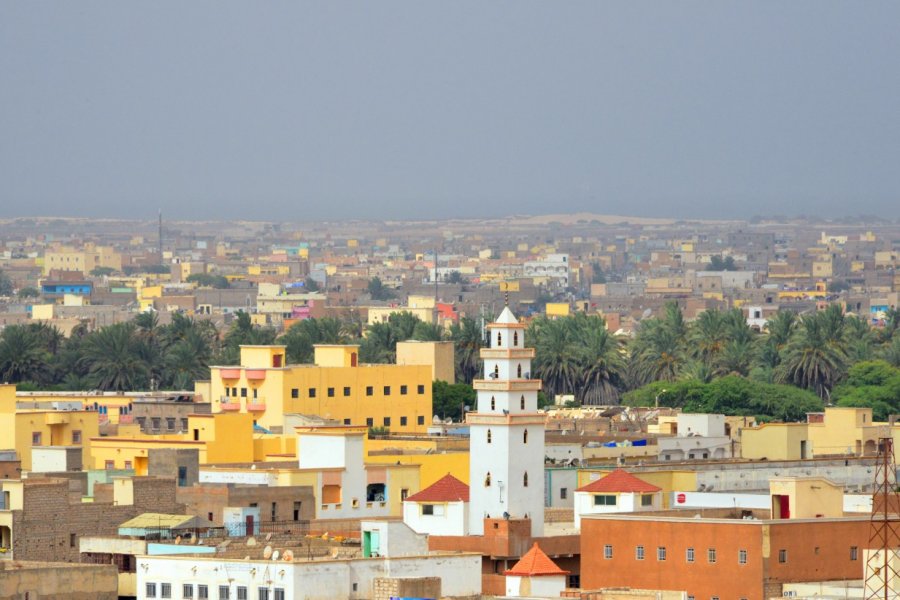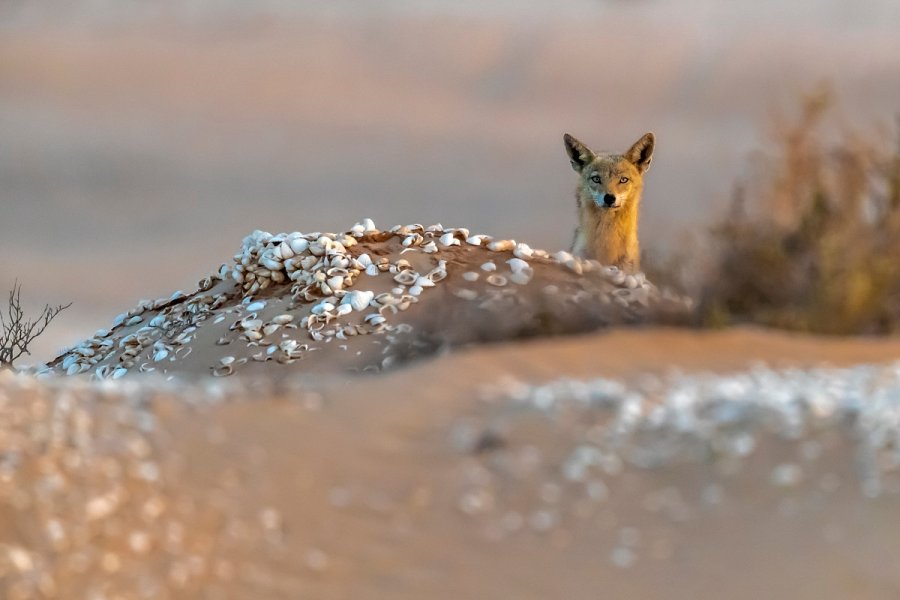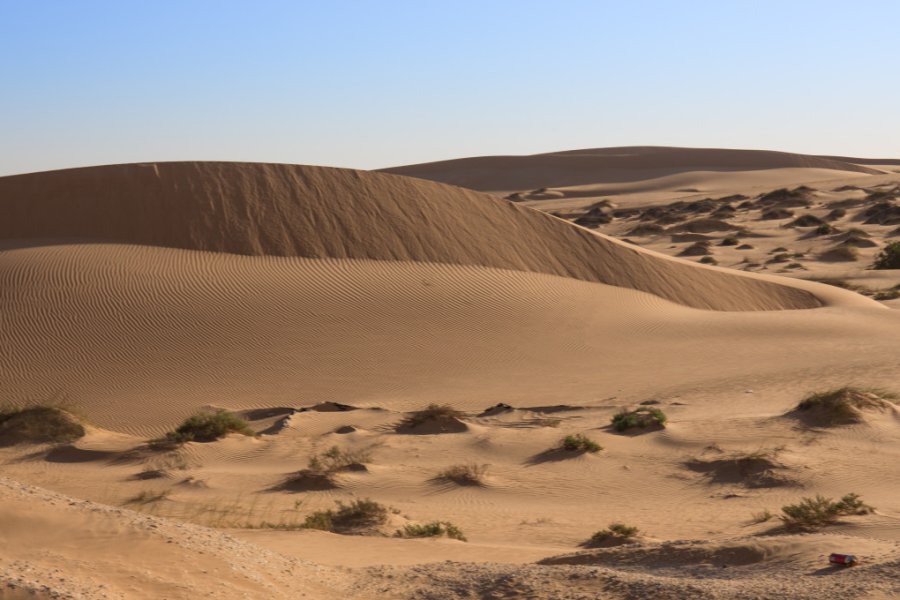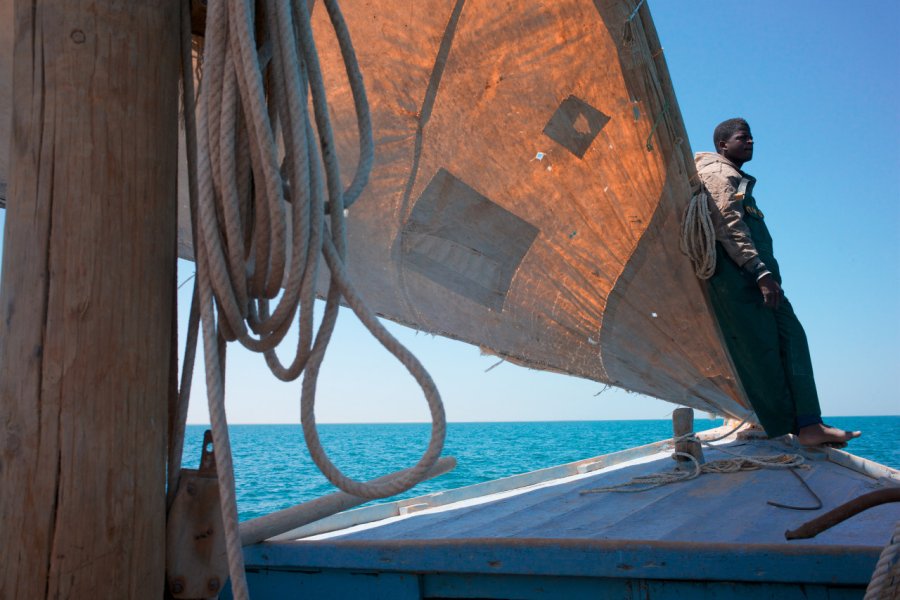Travel guide Mauritania
Dreaming of unexplored horizons and deserts as far as the eye can see? Set course for Mauritania! Thanks to the efforts made by the authorities to guarantee security, the country is now mostly open to tourism, with the exception of a few border areas. At the crossroads between the Maghreb and sub-Saharan Africa, discover thisWest African country with our Mauritania travel guide. Equally divided between Arab-Berber and Black-African communities, the population proudly maintains its tribal ties. This country is a living crossroads, where trade and adventure coexist. From caravans to the all-terrain vehicles of Western travelers, Mauritania's roads lead to destinations as diverse as Senegal and Mali. Here are the most beautiful sites not to be missed!
Stroll the centuries-old streets of Chinguetti, a holy city in the desert where libraries hold treasures of ancient manuscripts. The town is the guardian of rare libraries. Feel the sea breeze on your face as you watch thousands of migratory birds at the Banc d'Arguin National Park. A must-see stopover. Nouakchott, the capital in transformation, is another must-see. The fish market delivers an experience as authentic as it is olfactory. This city is a cocktail of tradition and modernity, where 4x4s live side by side with camels.
And don't miss the Senegal River valley, where you can cruise by pirogue through lush Mauritania, the antithesis of its arid image. And don't forget to sample Mauritanian cuisine: a festival of tastes awaits you in the restaurants. Fish dishes and mechouis reign supreme here.
Enjoy the hospitality ofthe hotels and share a mint tea in a Berber tent. In terms of nature, the Adrar offers superb lunar landscapes for trekkers. But beware: this country with its extreme climate does not forgive carelessness. The illusion of infinite space and unfettered freedom can quickly turn to danger in this shadowless desert. A destination for the adventurous, but always cautious.
What to see, what to do Mauritania?
-
Book an activity
-
Customized travel
- The most beautiful cities Mauritania
When to go Mauritania ?
Mauritania offers a diversity of climates and experiences, and the best time to visit this West African country is from November to February, when the weather is pleasant, especially if you plan to explore the desert regions. This is the dry season, and temperatures are more bearable.
January in Mauritania is particularly recommended for adventurers wishing to explore the dunes of the Erg Ouarâne without suffering the scorching desert heat.
If you're a budding birdwatcher, consider a trip between November and April. The Banc d'Arguin National Park, a UNESCO World Heritage Site, is the scene of an impressive bird migration.
For more affordable rates, May to October is the low season. However, expect high temperatures, especially if you travel in July or August. This period is less recommended for trekking or long desert excursions.
When to go to Mauritania for cultural events? As the country is predominantly Muslim, festivals and celebrations are often linked to the Islamic calendar, which is lunar. This means that dates vary from year to year, but if you can plan your trip around Ramadan or Eid, you'll have the opportunity to experience some unique cultural moments. Don't forget to check our travel advice and restrictions before planning your Mauritanian adventure.
Suggested addresses Mauritania
Travel Mauritania
-
Find a hotel
-
Car Rental
-
International e-SIM package
-
Find a local agency
On peut voyager de différentes manières en Mauritanie, le choix des itinéraires et du style de voyage est défini par la durée du séjour. Si vous restez environ 8 jours, le circuit organisé classique vous fera visiter Atar, Chinguetti, l’oasis de Terjît et peut-être Ouadâne.
Pour avoir une petite idée du pays et de la qualité d’accueil de ses habitants, la durée minimale de séjour est de 15 jours. Vous pouvez louer un 4X4 avec chauffeur (talent de négociateur exigé !). Il vaut mieux être plusieurs car vous louez le véhicule et non la place : comptez environ 120€ par jour (véhicule + chauffeur). Faire marcher la concurrence est le meilleur moyen d’obtenir le bon prix, mais cette solution est aussi pratique qu’onéreuse.
Autre possibilité : emprunter les transports locaux. Elle demande patience, condition physique et mentale, et une certaine « forme de pensée africaine », mais récompense par la convivialité de vos compagnons de voyage.
Find unique Stay Offers with our Partners
How to go Mauritania
How to go alone
Going off on your own in Mauritania is an exhilarating and challenging adventure. To make the experience a success:
Before you leave, find out about the sites to visit, the distances between towns and the modes of transport available. This will help you draw up a realistic itinerary.
Learn a few phrases in Arabic or local dialects to facilitate communication and create bonds with the locals.
Avoid traveling at night, and always inform someone of your itinerary. Take a first-aid kit and essential medicines with you.
Book at least your first few nights in a hotel to avoid searching for accommodation at the last minute.
Mauritania is a Muslim country, so dress accordingly and respect local traditions, especially during the holy month of Ramadan.
Travelling alone sometimes means leaving your comfort zone. Be open to new experiences, encounters and the unexpected!
How to go on a tour
Organized trips to Mauritania are a great idea! Here's what you need to know:
Make sure you select an agency with a good reputation.
Choose an itinerary suited to your level of comfort and endurance.
Set a budget and make sure you understand what's included (accommodation, meals, tours, etc.) and what's not.
If you prefer a more intimate experience, look for agencies that offer trips in small groups. This can allow for greater immersion and easier access to certain sites.
Don't forget to check formalities such as vaccinations and visas.
Opt for agencies that take an eco-responsible approach and work in collaboration with local communities.
That way, you'll have everything you need to discover Mauritania without the hassle of logistics!
How to get around
Mauritania offers vast stretches of desert, making it a real challenge to get around. Here are a few tips:
Opt for public transport or cabs in the main towns. Buses and minivans are economical but often overcrowded.
Rent a car adapted to the trails to explore the country at your own pace.
Try out the railway line linking Nouadhibou to Zouérat. It's a must for admiring the Saharan landscape.
And for more remote areas, consider joining a group or hiring a local guide. They know the best routes and common pitfalls.
Getting around Mauritania requires a certain amount of preparation and caution, but the spectacular scenery and warm welcome from the locals are more than worth it.
Discover Mauritania
Are you getting ready to leave for Mauritania? Great idea. Your bag is packed? Perfect! Now all you have to do is discover the many facets of this exciting country! In the following pages, you should find answers to the various questions you may have: What are the national culinary specialties? What sports do the locals love? What are the cultural events that cannot be ignored? What are the main climatic characteristics of the various regions of the country? Which contemporary artists should be discovered? What are the economic challenges facing the Mauritanian state at the beginning of the 21st century? What are the key dates in the history of this territory? What are the emblematic animals and plants of this part of the continent? And so on ! We wish you a good reading.
Pictures and images Mauritania
The 12 keywords Mauritania
1. Dromedary

It has all the qualities to adapt to the difficult conditions of the desert, can travel more than 150 km in a day, without water, loaded with humans and / or goods ... Its meat and milk are part of the Mauritanian diet, especially for nomads. The dromedary is everywhere in the country, and an indispensable!
2. Gum arabic

Member of the acacia family, the gum tree has been exploited for its sap, used in the pharmaceutical field, confectionery, etc. Although it is gradually being replaced by synthetic products, it is an essential dune fixer: its numerous roots retain sand and fertilize the soil. And it feeds dromedaries and goats!
3. Hassanya
The Hassanya dialect is the mother tongue of a Moorish population of Arab or Arabized Berber origin. Spoken by nomads and Bedouins, it has evolved little and has more vowels than other dialects of the Maghreb. Hassanya has an oral tradition, and is written in literary Arabic. Lesson 1: "m'borou" = bread!
4. Khaïma
The khaïma or desert tent is emblematic of nomadic culture in Mauritania. Carpets and mattresses on the floor, a few cushions and the family rests together, languid, sheltered from the sun, wind and sandstorms. Despite sedentarization, the khaïma is still used in town for major events such as weddings, feasts and festivals.
5. Languor
Is it the inexorable advance of the desert? The bite of the sandy wind that forces us to wait? The merciless heat that overwhelms? In Mauritania, we live to the exacting rhythm of nature, mistress of these places, and far from the hustle and bustle of the world, we accept and wait. Tourists enjoy a legendary languor that will soon make them nostalgic.
6. Mashallah
Islamic expression meaning "what Allah has willed". It's used all day long in Mauritania, to congratulate someone, to emphasize beauty in all its forms, and as a punctuation mark. It's sure to become an integral part of your vocabulary on your return: you'll be talking about your trip with "Mashallah"!
7. Melhafa
Originally from the Sahel, designed to protect against wind and heat, it is the symbol of elegance and enhances women's beauty. Dressing in it is a ritual that has spanned the centuries. Tied around the body, it covers shoulders and hair before being folded over the left shoulder. You can even tell a woman's age and status by her melhafa.
8. Date palm
This tree, cultivated since ancient times, was introduced to Mauritania by the Berbers, who planted it in the middle of the desert, where there were springs: oases were created! The roots of the date palm can drink up to 10 meters underground... In February-March, the trees are fertilized, and in summer the date, the fruit of providence, is celebrated.
9. Raft of the Medusa
This masterpiece, painted in 1817 by Théodore Géricault, recounts the odyssey of the Méduse : in 1816, a French ship and its 400 sailors set sail off the coast of Mauritania. But the shallows of the Arguin shoal were the ship's undoing! Taking refuge on a raft that ran aground, the 150 shipwrecked sailors ended up eating each other! Only 15 escape.
10. Sahara

The Sahara occupies two-thirds of Mauritania's land surface. It is the world's largest desert, covering some 9,000,000 km2! Once fertile, the Sahara stretches further south every day. Wherever water surfaces, oases emerge, saving the lives of nomadic groups, which are becoming rarer these days.
11. Tea

Here, the day revolves around 2 priorities: the 5 prayers, and tea. Tea is a veritable ceremony, expressed in 3 "j "s: "jmaa" the group, "jmar" the ember, "jar" the time. Wherever you are, you'll be invited to a tea that you'll taste 3 times: bitter like life, strong like love, and sweet like death.
12. Zrig
This drink is a traditional beverage available in Mauritania almost at will! This is dromedary milk, best consumed immediately after milking. It can also be slightly fermented, diluted with water and sweetened. In the desert, if you come across them, it's the nomads' welcome drink!
You are from here, if...
You drive through the city with a camel in the back of your pick-up.
You eat couscous with whole wheat semolina on Friday, the day of prayer, for parties, or for guests.
You wear a chèche, leaving only your eyes visible, sometimes even hidden behind sunglasses on stormy days.
You cook your al kesra (wheat or barley cake) in the sand.
You leave the city to spend the weekend in the bush.
Your daily life is disrupted by frequent power and water cuts.
To guide someone, you tell them to "take the tar and turn at the fifth tap!
Donkeys, zebus or dromedaries share the road with your vehicle.
To say hello, you ask: "and how is the family? How is your health? And this morning? And this heat? And...".
To any request, whether it is urgent or not, you answer "Yes... Inch'Allah!






















